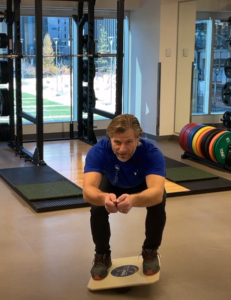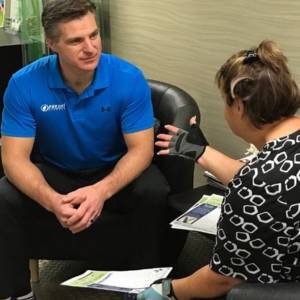Today we’re going to talk about squats. Now squatting is one of the most common exercises that people do in the gym and that we do in day-to-day life. For skiing, it’s fantastically important.
Now, this is where we start to pile on all the different things we’ve talked about in previous videos. Our posture, our bracing, our breathing, the alignment, the leg strength.
So a basic squat.
I usually get people to just cross arms over shoulders and then squat down, come back up. In the previous video on the lunges and the lateral weights, we have to talk about knee and toe positions. We still want to have a connection from the ball of the bigfoot through our foot all the way up to the knees and through the hips. Now our knees should face the outer half of the foot.
A lot of those people when they squat the knees dip in like this or they’re way past there and the ball of the big toe is coming off the ground.
I want you to think about keeping the foot flat.
Press the ball of the big toe into the ground. Keep those knees aligned with the outer half of the foot, pelvic position bracing and we’re just going to sit back if we’re sitting in a chair. Come down to the bottom of the motion and hold there. Now from the side, the middle of your chest is going to be right over the arch of your foot.
If you have longer legs, maybe a long femur, it’s going to push your hips back a bit more. You might have to lean forward more as long as you have a good posture that’s okay. I want to be in this position. If your back bounds or your butt sticking out here, you want to set that position, come down, pull.
You can check out the app from FRESH! Wellness Group. It’s available on Apple (iOS) or Android.
Once we’re there this is a great opportunity to practice your breathing.
So we’re going to hold the core, breathe into that propane canister we talked about in the breathing video, and just hold it. Imagine you’re tucking down the hill. Post is there, your bracing is going well, this is where the endurance comes in. Can you hold that position? Can you breathe effectively? If you can’t take it anymore, come back, shake the legs, node, and then you can repeat it.
Quality motions make a big difference.
Now, if you want to get a bit more advanced and you feel that the basic squats are doing well, you can add more load to it which is great. Throw a barbell on your shoulders, hold a dumbbell in front of you, kettlebell put a weighted west on. Your body doesn’t care where the resistance comes from. Just progress it a little bit at a time.

From a bit more of a balanced perspective, I love this balance board because you can set it to only one plane.
So on this one what I like to do for skiing is come up and have the side to side balance. And again, we don’t have to be set the whole time if we are not completely stable, but when we come down to our squat, imagine we’re talking, we’re able to adjust, maintain the core and we’re making those second by second micro-adjustments, continuing to keep our feet flat, okay? And holding down there. Come back up, step off, shake the legs out.
Now if you’re a snowboarder, then what we would do is, switch it the other way so you can practice your heel-toe control. But it’s a ski video we’re not going to talk too much about snowboarding, although rotation, posture, balance, breathing, all those things are just as critical for snowboarding as they are for skiing.
So test out some of the tools, but most importantly test out your ability to hold the position regardless of what you’re doing.
Try to post comments. I’d love to hear what you think.
Make sure to check out our on-demand Functional Movement Foundations workshop! It’s your ticket to a fun, fit, and strong ski season. And it’s 50% off with this promo code: SkiFit50



